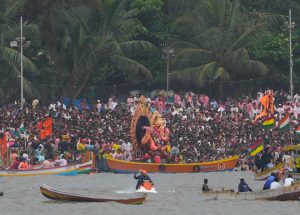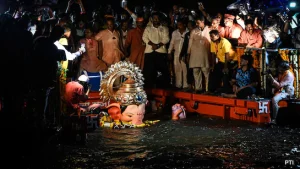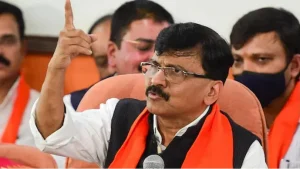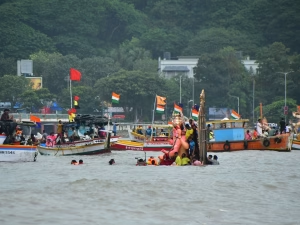Maharashtra – The Lalbaugcha Raja immersion at Mumbai’s Girgaon Chowpatty experienced an unprecedented delay of nearly 13 hours this year, marking a significant departure from decades-old traditions. The 18-foot-tall iconic Ganesh idol, revered by millions of devotees, faced multiple challenges that prevented the customary morning immersion ceremony from proceeding as planned.
This extraordinary delay in the Lalbaugcha Raja immersion has sparked controversy and disappointment among devotees, particularly the fishermen community who played a crucial role in establishing this beloved Mumbai tradition. The incident highlights growing tensions between modernization efforts and traditional practices that have defined the festival for nearly nine decades.
High Tide and Technical Failures Disrupt Sacred Ceremony

The Lalbaugcha Raja immersion traditionally begins its procession on Anant Chaturdashi, the final day of the Ganesh festival, with the actual immersion occurring the following morning around 9 AM. However, this year’s ceremony faced insurmountable obstacles that forced organizers to postpone the sacred ritual until 10:30 PM.
Organizers cited high tide conditions in the morning as the primary factor preventing the scheduled Lalbaugcha Raja immersion. The elevated sea levels made it impossible to safely conduct the ceremony at Girgaon Chowpatty, forcing officials to wait until tidal conditions became favorable for the religious proceedings.
The delayed timing coincided with the ‘sutak period,’ a spiritually significant but inauspicious time during the lunar eclipse. This unfortunate confluence created considerable discomfort among devotees who had gathered for the traditional morning Lalbaugcha Raja immersion ceremony, disrupting their religious observances and travel plans.
Abandonment of Traditional Floating Platform


A significant tradition broken during this year’s Lalbaugcha Raja immersion involved the ceremonial floating platform used for the sacred ritual. Historically, the immersion occurred from a specially constructed platform made from boats belonging to Mumbai’s Koli (fishermen) community, symbolizing their integral role in the festival’s origins.
However, technical problems with this traditional platform system caused additional delays, leaving the massive idol stranded at Girgaon Chowpatty for several hours. The technical snags exposed the vulnerabilities of attempting to modernize age-old practices without proper backup systems for the Lalbaugcha Raja immersion.
The departure from traditional methods angered the fishermen community, who felt increasingly marginalized in a festival they helped establish. Their boats had served as the foundation for the immersion platform since the tradition began, making this change particularly symbolic of their perceived exclusion.
Fishermen Community Voices Displacement Concerns
Members of the fishermen community expressed deep frustration about their systematic exclusion from the Lalbaugcha Raja immersion proceedings. They revealed that their ancestral connection to the festival dates back to 1934, when struggling fishermen and laborers made a sacred vow to Lord Ganesh seeking relief from market difficulties.
The fishermen explained that Lalbaugcha Raja was established following their successful prayer, making their participation not merely traditional but spiritually foundational. They lamented how their access to the festival has been progressively reduced from a full day to a few hours, and eventually to complete exclusion from the Lalbaugcha Raja immersion ceremony.
“Earlier, on the day of immersion in the sea, we used to get the privilege of having the last ‘darshan’ of Lord Ganesh from our boat and participating in the immersion, but this year we were deprived of that too,” community members stated. They viewed the technical failures as divine intervention, allowing them to offer prayers during the extended delay.
VIP Culture Controversy and Political Reactions
The Lalbaugcha Raja immersion controversy extends beyond logistical issues to encompass broader concerns about VIP culture infiltrating religious spaces. The fishermen community accused organizers of treating devotees unfairly while prioritizing VIP access, creating a two-tiered system that contradicts the festival’s egalitarian origins.


Shiv Sena (UBT) leader Sanjay Raut addressed these concerns, revealing that he has never visited Lalbaugcha Raja to avoid adding to crowd management challenges. His comments highlighted the complex relationship between political participation and religious accessibility during the festival.
“I have never been to Lalbaug Ganpati till now. What is seen there is different. I don’t go because I don’t want to add one more person to the crowd,” Raut explained, criticizing the current VIP-dominated atmosphere surrounding the celebrations.
Security Challenges and Criminal Activities
The extended Lalbaugcha Raja immersion period coincided with increased criminal activities, with at least 50 mobile phones stolen during the procession. Police also reported seven cases of gold chain theft, highlighting security challenges created by the massive crowds and extended timeframe.
Law enforcement arrested 15 people in connection with these crimes, recovering stolen property and registering multiple cases. The incidents underscore the complex logistical challenges involved in managing such large-scale religious gatherings.
Community Demands for Inclusive Participation

The fishermen community’s primary demand centers on including a representative in the organizational structure to ensure their voices are heard in future Lalbaugcha Raja immersion planning. They seek recognition of their historical role and rights within the festival framework.
This year’s disrupted Lalbaugcha Raja immersion serves as a catalyst for broader discussions about balancing tradition with modernization, ensuring inclusive participation while managing massive crowds, and maintaining the spiritual essence of Mumbai’s most beloved Ganesh celebration.

